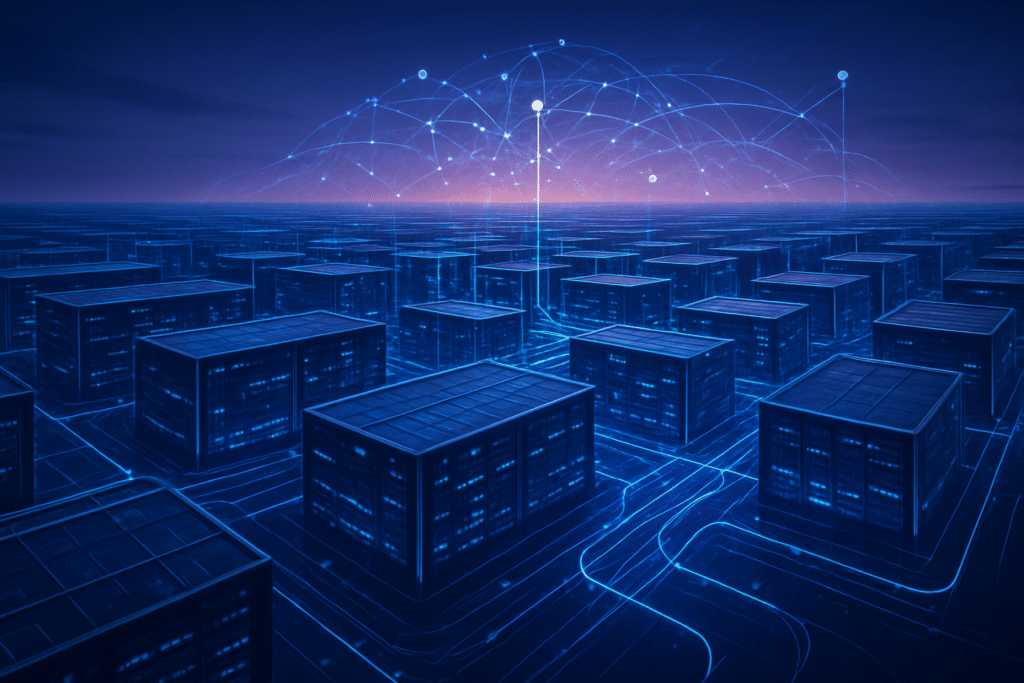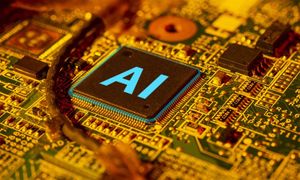
Microsoft (NASDAQ: MSFT) is embarking on an unprecedented infrastructure expansion, committing over $110 billion to build and upgrade AI-optimized data centers globally through 2028. This colossal investment, the largest in the company's history, signals a pivotal moment in the race for AI dominance, aiming to solidify Microsoft's position as the foundational infrastructure provider for the next generation of artificial intelligence. With over half of the fiscal year 2025's planned $80 billion investment earmarked for projects within the United States, this strategic move is set to profoundly impact the capabilities of AI, cloud computing, and the global technological landscape.
The immediate significance of this massive outlay lies in its potential to dramatically accelerate the development and deployment of advanced AI models. By establishing a vast network of hyperscale AI factories, Microsoft is not merely increasing computing capacity; it is engineering a purpose-built ecosystem designed to handle the insatiable demands of multimodal AI, sovereign cloud solutions, and the company's rapidly expanding Copilot offerings. This aggressive push is a clear declaration of intent to outpace rivals and underpin the AI revolution with unparalleled computational power and integrated services.
Engineering the AI Future: A Technical Deep Dive into Microsoft's Hyperscale Ambition
Microsoft's new generation of AI data centers represents a significant leap forward in technical design and capability, fundamentally differing from traditional data center architectures. These facilities, often referred to as "AI factories," are meticulously engineered to support the intensive demands of large-scale AI and machine learning workloads, particularly the training and inference of massive language models.
At the heart of these new centers lies an unprecedented deployment of advanced Graphics Processing Units (GPUs). Microsoft is integrating hundreds of thousands of cutting-edge NVIDIA (NASDAQ: NVDA) GB200 and GB300 GPUs, crucial for handling the parallel processing required by complex AI models. Each GB200 rack, for instance, offers 1.8 terabytes of GPU-to-GPU bandwidth and access to 14 terabytes of pooled memory, capable of processing an astounding 865,000 tokens per second. Beyond third-party hardware, Microsoft is also developing its own custom silicon, including the Azure Integrated HSM for enhanced security and a Data Processing Unit (DPU) to optimize cloud storage performance. This "end-to-end AI stack ownership" strategy, from silicon to software, aims for unparalleled performance and efficiency.
The networking infrastructure within these AI data centers is equally revolutionary. High-speed interconnects like NVLink and NVSwitch operate at terabytes per second within racks, while InfiniBand and Ethernet fabrics deliver 800 Gbps across multiple racks in a full fat-tree non-blocking architecture. This "single flat networking" allows hundreds of thousands of GPUs to function cohesively as one massive AI supercomputer, with two-story rack layouts meticulously designed to minimize cable lengths and latency. Such specialized networking is a stark contrast to the leaf-and-spine cabling common in general-purpose data centers, which would be insufficient for AI's bandwidth requirements.
Furthermore, the sheer power density of AI hardware necessitates advanced cooling solutions. Microsoft employs closed-loop liquid cooling systems that circulate cold liquid directly into servers, efficiently extracting heat with "zero water waste." Facilities like the Fairwater data center in Wisconsin, for example, utilize the second-largest water-cooled chiller plant globally. This specialized approach is critical, as AI hardware demands significantly more power (40-110 kW per rack, potentially over 200 kW) compared to the 5-10 kW per rack typical in traditional air-cooled data centers. Initial reactions from the AI research community and industry experts acknowledge the transformative potential of these investments, recognizing Microsoft's strategic move to maintain a leading position in the competitive AI cloud race. However, concerns about the immense resource requirements, particularly electricity and water, are also prominent, prompting Microsoft to emphasize sustainability efforts and carbon-negative water usage in its designs.
Reshaping the AI Battleground: Industry Impact and Competitive Dynamics
Microsoft's gargantuan investment in AI data centers is fundamentally reshaping the competitive landscape, creating significant strategic advantages for the tech titan while intensifying the "AI arms race" among its rivals and presenting both challenges and opportunities for other AI companies and startups.
For tech giants like Amazon (NASDAQ: AMZN) with AWS and Alphabet (NASDAQ: GOOGL) with Google Cloud, Microsoft's aggressive expansion escalates the competition in cloud AI services. While AWS currently holds the largest cloud market share, Microsoft Azure is rapidly gaining ground, driven largely by its robust AI offerings. Google Cloud is also demonstrating strong growth, sometimes even surpassing Microsoft in year-on-year growth in certain quarters, particularly due to surging AI demand. The battleground has expanded beyond software to foundational infrastructure, compelling all major players to invest heavily in building out vast data center networks and developing custom AI chips, such as Google's TPUs and AWS's Graviton, Trainium, and Inferentia. The recent multi-year, $38 billion agreement between OpenAI and AWS for cloud infrastructure further highlights the fierce competition for powering leading AI models, demonstrating a shift towards multi-cloud strategies for AI workloads.
Microsoft's strategic advantages stem from its end-to-end AI stack ownership, encompassing custom silicon, software, and physical infrastructure. Its deep partnership with OpenAI, including a reported $13 billion investment and a 27% stake, has provided early access to advanced AI models, enabling rapid integration into its core products like Azure AI Services and the Copilot suite. This allows Microsoft to offer a highly integrated and optimized AI ecosystem, appealing to enterprise clients. Furthermore, Microsoft is actively engaged in a "talent war," recruiting top AI researchers and engineers, sometimes from rival startups, to bolster its capabilities.
For other AI companies and startups, Microsoft's massive investment creates a dual impact. On one hand, the astronomical costs associated with developing advanced AI—requiring tens of billions for specialized hardware, data centers, and top-tier talent—significantly raise the barrier to entry for smaller players, concentrating power among a few well-capitalized tech giants. On the other hand, opportunities arise through strategic partnerships and specialization. Microsoft is actively collaborating with and investing in specialized AI startups focusing on infrastructure, tooling, and niche applications. Startups providing "picks and shovels" for the AI gold rush, such as specialized AI hardware (e.g., Lambda, which secured a multi-billion dollar contract with Microsoft) or cloud platforms optimized for AI workloads, stand to benefit. However, smaller innovative companies risk becoming acquisition targets or being outcompeted if they cannot secure significant funding or differentiate themselves within the rapidly evolving industry.
The Broader AI Canvas: Impacts, Concerns, and Historical Parallels
Microsoft's monumental investment in AI data centers is a defining feature of the current AI landscape, fitting squarely into a period characterized by an "AI arms race" among tech giants and the explosive growth of generative AI. This commitment not only accelerates technological advancement but also raises significant societal and environmental concerns, drawing comparisons to previous technological revolutions.
The broader AI landscape is currently defined by an unprecedented surge in demand for computational power, primarily driven by the development and deployment of large language models (LLMs). Private investment in generative AI reached $33.9 billion in 2024, an 8.5-fold increase from 2022, underscoring the rapid expansion of the sector. Microsoft's strategy to build multi-gigawatt, AI-first campuses, integrating GPU supply, custom chip ecosystems, and secure power sites, is a direct response to this demand. Projections suggest that approximately 33% of global data center capacity will be dedicated to AI by 2025, potentially reaching 70% by 2030, fundamentally reshaping the global digital infrastructure.
The wider societal and technological impacts are profound. Economically, Microsoft emphasizes extensive job creation in construction, manufacturing, and technology, predicting the emergence of "next billion AI-enabled jobs." Technologically, this infrastructure fuels the rapid development and deployment of next-generation AI models and applications across diverse sectors like healthcare, finance, and transportation. By controlling the underlying infrastructure, Microsoft aims to exert significant influence over the foundation of future digital services, fostering platform dominance akin to the early days of the internet.
However, these advancements come with substantial concerns. The environmental impact is perhaps the most pressing: AI data centers are incredibly energy-intensive. Global data center electricity consumption is projected to double by 2026, largely due to AI, straining electricity grids and potentially hindering clean energy goals. Microsoft's own carbon emissions have increased by 30% since 2020 due to AI infrastructure expansion, leading to a revision of its climate commitments. Furthermore, data centers require vast amounts of water for cooling, which can strain local water supplies. Ethical concerns also loom large, including the potential for AI tools to perpetuate biases from training data, new privacy and security risks due to sensitive data access, and the exacerbation of misinformation. The potential for job displacement due to AI automation remains a significant societal worry.
Comparing this to previous AI milestones reveals a stark difference in scale and infrastructure centrality. While earlier AI breakthroughs, such as Deep Blue beating Garry Kasparov or AlphaGo defeating Lee Sedol, were remarkable, they did not necessitate the kind of massive, purpose-built physical infrastructure seen today. The current era of generative AI demands unprecedented computational resources, making data centers critical global infrastructure. The investment scale, with corporate AI investment reaching $252.3 billion in 2024, dwarfs previous periods, highlighting a fundamental shift where physical infrastructure is as crucial as the algorithms themselves. This period marks not just an algorithmic breakthrough, but an infrastructural revolution that will integrate AI into nearly every facet of business and daily life at an accelerated pace.
The Horizon of AI: Future Developments and Looming Challenges
Microsoft's massive AI data center investments are poised to drive significant near-term and long-term developments, unlocking a vast array of potential applications while simultaneously presenting formidable challenges that industry experts are closely monitoring.
In the near term (2025-2026), Microsoft plans to rapidly expand and upgrade its infrastructure, deploying cutting-edge AI and cloud-computing hardware, including hundreds of thousands of NVIDIA GPUs. Facilities like the "Fairwater" AI data center in Wisconsin, expected to be operational in early 2026, exemplify this focus on building the world's most powerful AI data centers. Concurrently, Microsoft is accelerating its in-house chip development, with products like the Arm-based Cobalt CPU and Maia AI accelerator aiming to reduce reliance on third-party providers. The immediate impact will be a dramatic increase in accessible compute power, solidifying cloud environments as the dominant platform for AI/ML workloads and enabling the training of even more sophisticated frontier AI models.
Looking further ahead, Microsoft's long-term vision extends to global reach, aiming to expand its international data center presence to 40 countries and seamlessly integrate these AI factories with its existing cloud network of over 400 data centers. The company is also committed to ambitious sustainability targets, striving to be carbon-negative by 2030 and water-positive through advanced cooling and atmospheric water capture. This long-term strategy includes mobilizing private capital through initiatives like the 'Global AI Infrastructure Investment Partnership' (GAIIP) to fund future data center and energy infrastructure projects. These developments will underpin a vast array of applications, from powering Microsoft's extensive Copilot ecosystem across its product suite to enabling advanced enterprise AI solutions, sovereign cloud environments for sensitive industries, and even "Copilot Edge Pods" for on-premise AI services in sectors like manufacturing and healthcare.
However, the path forward is not without significant hurdles. The most pressing challenge identified by Microsoft CEO Satya Nadella is power availability, which he states is now a greater bottleneck than chip supply. The immense energy demands of AI data centers, projected to account for up to 49% of total data center power consumption by the end of 2025, are straining electricity grids globally. Environmental impact, supply chain issues, and market volatility, including concerns about potential overcapacity, also remain critical challenges. Experts predict a continued dominance of cloud environments for AI compute, with the AI compute layer remaining highly concentrated among a few tech giants. While some, like OpenAI CEO Sam Altman, predict a temporary scarcity of computing power followed by an oversupply, others warn of a potential "AI bubble" driven by speculative growth projections. Analysts at Morgan Stanley estimate global spending on data centers could reach nearly $3 trillion by 2028, highlighting the scale of this ongoing infrastructural revolution.
The AI Inflection Point: A Comprehensive Wrap-Up
Microsoft's staggering $110 billion investment in AI data centers marks a profound inflection point in the history of artificial intelligence and cloud computing. This unprecedented commitment is not merely an expansion of existing infrastructure; it is a strategic re-engineering of the foundational layer upon which the next era of AI will be built. The key takeaways are clear: Microsoft (NASDAQ: MSFT) is making an aggressive play for long-term AI dominance, betting on the imperative of hyperscale, purpose-built infrastructure to power the future of intelligent systems.
The significance of this development in AI history cannot be overstated. It underscores the shift from purely algorithmic breakthroughs to a recognition that physical infrastructure—massive data centers, specialized GPUs, advanced cooling, and optimized networking—is equally critical for pushing the boundaries of AI. This investment dwarfs previous AI milestones in terms of capital expenditure and resource intensity, signaling a new era where the sheer scale of computational power is a primary determinant of AI capability. It positions Microsoft as a central enabler, not just a participant, in the AI revolution, providing the essential "picks and shovels" for the burgeoning AI gold rush.
Looking ahead, the long-term impact will be transformative. We can expect accelerated innovation in AI models, a proliferation of AI-powered applications across every industry, and a deepening integration of AI into daily life through services like Copilot. However, this journey will be accompanied by significant challenges, particularly concerning energy consumption, environmental sustainability, and the ethical implications of pervasive AI. What to watch for in the coming weeks and months includes further announcements regarding specific data center projects, advancements in Microsoft's custom AI silicon, and the ongoing competitive responses from rival tech giants. The true measure of this investment will be its ability to not only drive technological progress but also address the complex societal and environmental questions it inevitably raises.
This content is intended for informational purposes only and represents analysis of current AI developments.
TokenRing AI delivers enterprise-grade solutions for multi-agent AI workflow orchestration, AI-powered development tools, and seamless remote collaboration platforms.
For more information, visit https://www.tokenring.ai/.





